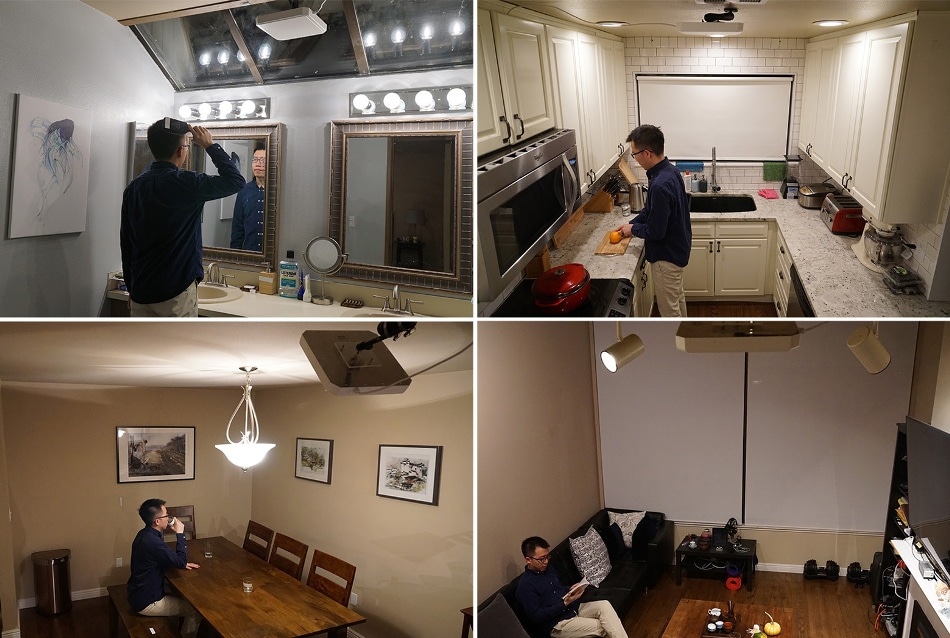Apr 10 2019
Many non-electronic objects such as coffee cups, yoga mats, pill bottles, and frying pans could be converted into a network of Internet of Things sensors using a novel RFID-based technology developed by the University of Michigan.
 RFID readers mounted to the ceiling gather data from IDAct stickers in the room. (Image credit: University of Michigan)
RFID readers mounted to the ceiling gather data from IDAct stickers in the room. (Image credit: University of Michigan)
Known as IDAct, the new system closes the gap between the projected 14.2 billion “smart” electronic devices that are now part of the Internet of Things as well as the countless number of day-to-day non-smart objects left out of the picture.
According to the researchers, it is a major step toward creating an IoT experience which is truly immersive.
Imagine a world where your pill bottle keeps track of your medication intake and water glass monitors your hydration level. Even your yoga mat is aware of your exercises and could adjust lighting, temperature and background music accordingly.
Alanson Sample, Study Author and Associate Professor, Electrical Engineering and Computer Science, University of Michigan
The novel technology could also be used in elder care settings, where it can be used to inconspicuously track daily activities and medications, thus aiding seniors to remain independent for a longer time without the added necessity for invasive and costly live-in care.
The IDAct system uses battery-free RFID tags and RFID readers that cost merely a few cents and is capable of sensing both the presence and movement of people in a room and also detecting the movement of objects with sufficient detail to establish, for instance, whether one has cooked a meal or shifted a pill bottle. The RFID tags can be fixed to almost any kind of object in the form of a sticker, while the RFID readers can be incorporated into day-to-day objects such as light bulbs.
Given the ubiquity of these objects, there are significant opportunities in enhancing their sensing capabilities and creating interactive applications around them.
Hanchuan Li, Study Lead Author and Former Graduate Researcher, Computer Science and Engineering, University of Washington
In a recent study, the technology precisely identified certain activities over 96% of the time.
You could imagine assistive tools that could help the elderly stay in their own homes longer by monitoring their daily activities with this technology. It could detect changes in eating, sleeping or medication, for example, before the situation deteriorates and they end up in the emergency room.
Alanson Sample, Study Author and Associate Professor, Electrical Engineering and Computer Science, University of Michigan
An article describing the IDAct system was presented at the iEEE RFID Conference in Phoenix Arizona on April 4th, 2019.
For years, RFID tags have been used for tracking objects in various applications like theft prevention and shipping. These tags absorb the required amount of electromagnetic energy from the RFID reader’s signal to broadcast a unique yet simple code. Earlier, the RFID reader merely sensed this code to spot whether the object was actually present or not—that is, on or off, signal or no signal.
By extending a more nuanced reading of the signal from the RFID tags, the IDAct system improves on this. In addition, it is capable of detecting even small changes in the signal coming back from the RFID tags to sense when an object has been shifted or whether an individual is touching it. It can even identify changes in the electromagnetic field of a room to deduce, for instance, when a person is present.
Every object causes electromagnetic interference in a specific way. We can use that information, along with information from RFID tags, to get a very detailed picture of what’s going on in a given space.
Alanson Sample, Study Author and Associate Professor, Electrical Engineering and Computer Science, University of Michigan
Subsequently, these enhanced signals are examined by a machine learning algorithm operated by an on-site computer to understand what exactly is occurring in a room. During the testing phase, this processing was carried out on a laptop; however, Sample believes that ultimately, the required hardware will be incorporated within the RFID reader itself.
To test the technology, the researchers equipped a volunteer’s apartment with an array of RFID readers and subsequently tagged household objects with RFID tags. Afterward, 26 hours of data were collected from each room in the presence of users, and also two hours of data were collected from empty rooms as a control.
The researchers are planning to look for industry partners that can help develop the technology for application in elder care settings. Li and Sample created the technology along with Shwetak Patel at the University of Washington and Raul Shal and Chieh-yih Wan of the Intel Corporation. The paper is titled “IDAct: Towards Unobtrusive Recognition of User Presence and Daily Activities.” Intel Labs supported the study.